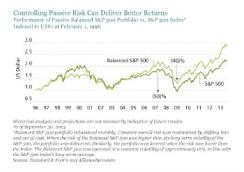In a recent blog post, “Passive Management Does Not Equal Passive Investing," we showed how passively managed portfolios actually create an active investment in which volatility is not benign and risk exposures can vary wildly over time. So if we could fix the problem and reduce exposure to spikes in market volatility, would a passive portfolio deliver better results?
To address this question, let’s understand how a passive investment is meant to create value in the first place. The key to successful passive investing is diversification. It’s a simple idea: Spread equal risk across investments and time, so that the portfolio operates at a constant risk level and exposures. The winners should outweigh the losers.
But varying risk exposures and risk levels are the enemy of the traditional passive approach. That’s because they lead to leaps in volatility. When a portfolio’s exposures are constantly changing, diversification isn’t given a chance to work.
For any investor, volatility can be especially damaging because of the effects of compounding. For example, a $100 investment in a high-volatility stock that rises 50 percent and falls 50 percent has lost $25. Yet an investment in a low-volatility stock that goes up 5 percent and falls 5 percent has only lost 25 cents. This pattern is caused by a phenomenon known as “risk drag.” Over the five largest down markets since 1926, the U.S. market-cap-weighted equities index lost 50 percent on average, which each time took nearly five years to recoup. This recovery period is known as the pain of risk drag. Diversification is supposed to reduce risk drag, which is the source of its value.
While these examples are extreme, they help illustrate the flaws of a traditional passively managed portfolio, in which diverse positions are not equal over time and fluctuate because of the dynamics of world markets and events. The good news is that this problem can be addressed by creating a portfolio that takes static and constant risk across industries.
To test the theory, we constructed a model portfolio — a “Balanced S&P 500” index tracker — that rebalanced each month to equalize risk exposures for each market-cap-weighted S&P 500 sector. We also operated the portfolio at the average long-term risk level of the index. Then we compared this portfolio with the S&P 500 index. As the chart shows, we found that by consistently maintaining equal risk exposures and constant overall risk, the portfolio would have returned 1.5 percent more per year on average than the S&P 500. And the drawdown — the peak-to-trough decline — would have been 20 percent lower, so an investor would have enjoyed higher returns with lower drawdown risk.

There are, of course, challenges to this approach. For example, as shown in the chart, as the Internet bubble inflated, the Balanced S&P 500 trailed the S&P 500 by a significant amount. At that time the S&P 500’s volatility was very high, and under such a condition taming the turbulence restrained market gains.
In fact, volatility is not always the best measure of risk because it acts to reduce not only outsize losses but also, unfortunately, outsize gains. But over time, our research suggests, clamping down on volatility and maintaining diversification should prevail. Investors should always remember that “winning the loser’s game” — as described in the classic book of that name by Greenwich Associates founder Charles D. Ellis — is all about losing less in down markets.
Traditional passive portfolios are susceptible to large drawdowns and unstable performance. We think that a better passive mousetrap can be built by striving for static risk across industries — and over time — to reduce risk drag and give diversification time to deliver results.
Ashwin Alankar and Michael DePalma are co–chief investment officers of tail-risk parity services, and Richard Abramson is managing director of client solutions, all at AllianceBernstein.
See AllianceBernstein’s disclaimer.
Get more on equities.





